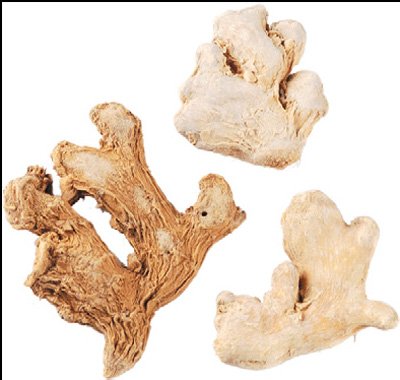Ginger
Ayurvedic Medicine

Ginger
Ginger (E), Adrakh (H), Sont (H):
Ardraka means 'moist' and sunthi means' dry'. It is also known as vishwabheshaja, the universal medicine benefiting everybody and all diseases (if you can say all in Ayurveda!), especially va-ta disorders. This is the herbalist's best friend. When using ginger think 'digestion, lungs and circulation'.
Cold Clears cold; fresh increases peripheral circulation and causes vasodilation and sweating. It clears ama from plasma and blood. Fresh ginger is more peripherally active while dry ginger is more centrally stimulating and warming (Mills & Bone 2000; the volatile and diaphoretic essential oils ?-sesquipphellandrene and zingiberene decompose on drying. The warming gingerol principle transforms into shogoals on drying, making it more centrally heating). Dry ginger may be of benefit in cardiac disorders due to increasing circulation and potential bloodthinning properties when used at a high dosage Mills & Bone 2000). Arthritis Dry ginger is used as an ama-clearing, s´lesaka kaphareducing, toxin-digesting, antiinflammatory in arthritis (amavata) in many traditional ayurvedic formulas, e.g. triphala guggul, yograj guggul. Lungs Clears phlegm in kaphavata coughs and colds. Digestion Warms the digestive system, increases agni and the secretion of digestive enzymes. Fresh ginger especially benefits rasadhatvagni while dry ginger clears ama and is better for kledaka kapha aggravations. Useful in nausea (morning, postoperative, and travel sickness), flatulence, griping. Specific activity against Escherichia coli and Shigella bacillus. Gynaecology Used in menstrual cramps—hot, fresh ginger tea. Regulates vata in the apanaksetra (lower abdomen). Despite its 'warm' energy it also inhibits the activity of inflammatory prostaglandins. It is a warming anti-inflammatory. Energetically, its sweet post-digestive effect is cooling. It also nourishes the s´ukra dhatu and reproductive system as a whole.
 Sarpagandha
Sarpagandha Mustard Seed
Mustard Seed Shatavari
Shatavari Gotu Kola
Gotu Kola Pippali
Pippali Jatamamsi
Jatamamsi Coriander
Coriander Ashwagandha
Ashwagandha Senna
Senna Mustaka
Mustaka Sandalwood
Sandalwood Rhubarb
Rhubarb Test your English Language
Test your English Language  Famous Mummified Bodies
Famous Mummified Bodies Tips to succeed in Work
Tips to succeed in Work Solar System
Solar System New Year Party Game Ideas
New Year Party Game Ideas The Highest Speed Cars in the world
The Highest Speed Cars in the world Tips to get ready for xmas
Tips to get ready for xmas International Sport Events
International Sport Events




